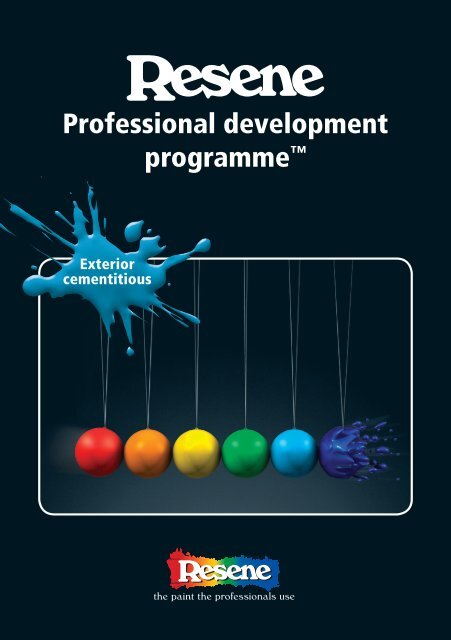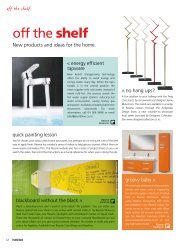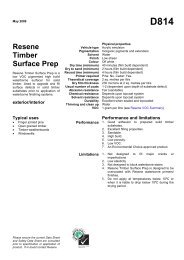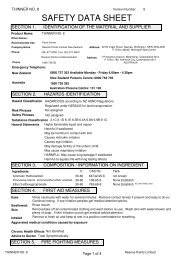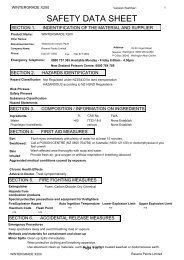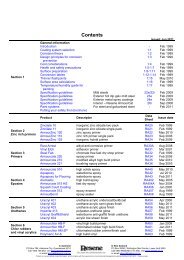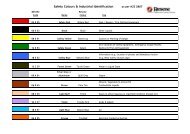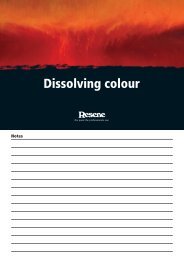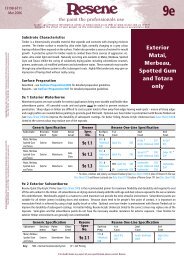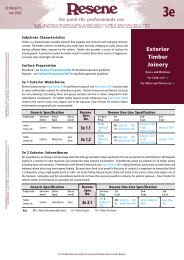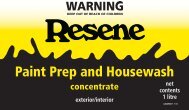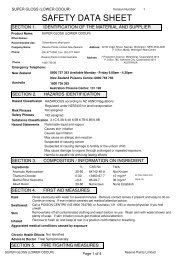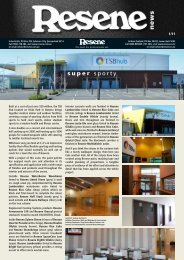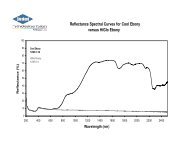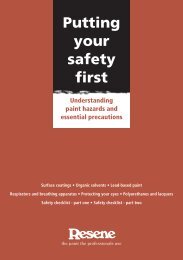Resene Professional Development - exterior cementitious surfaces
Resene Professional Development - exterior cementitious surfaces
Resene Professional Development - exterior cementitious surfaces
You also want an ePaper? Increase the reach of your titles
YUMPU automatically turns print PDFs into web optimized ePapers that Google loves.
<strong>Professional</strong> development<br />
programme <br />
Exterior<br />
<strong>cementitious</strong>
<strong>Resene</strong> <strong>Professional</strong> development programme<br />
New unpainted concrete<br />
Wash down with <strong>Resene</strong> Paint Prep<br />
and Housewash to remove dirt, oils<br />
and other contaminants<br />
Fill cracks and voids<br />
- Cracks under 1mm,<br />
use <strong>Resene</strong> Brushable Crack Filler<br />
- Cracks over 1mm, use Selleys No More<br />
Gaps <strong>exterior</strong> formulation or similar<br />
- Holes and voids, use either <strong>Resene</strong><br />
Jointflex or an approved masonry filler<br />
Prime using <strong>Resene</strong><br />
Concrete Primer<br />
Refer to topcoat<br />
systems flowcharts<br />
NOTE: <strong>Resene</strong> Limelock may be used on new concrete and plaster to enhance the cure and hold back<br />
limestaining. It is most effective when applied during the construction stage.<br />
1
<strong>Resene</strong> <strong>Professional</strong> development programme<br />
• How long has the concrete or plaster had to cure<br />
• Does it have any cracks or voids that will need filling<br />
• How large are they<br />
• Do you have any waterproofing issues<br />
• How big is the area to be painted and how smooth (or rough) is the surface<br />
New unpainted concrete<br />
• Concrete (and thickly applied plasters) may take up to 28 days to fully cure and, unless <strong>Resene</strong><br />
LimeLock is used, should not be painted before this time.<br />
• Curing and release agents will need to be removed from concrete before painting. In most cases<br />
<strong>Resene</strong> Paint Prep and Housewash will do the job, but for stubborn release agents a stronger<br />
product like <strong>Resene</strong> Emulsifiable Solvent Cleaner should be used.<br />
• Plasters, masonry finishes and cement sheets will collect dust and windblown contaminants, such<br />
as salt, on the surface. A thorough wash and hose down should be sufficient to remove plaster<br />
dust etc from the surface.<br />
• Concrete will sometimes have minor cracks and bug holes. These are best filled with plaster, such<br />
as Rockcote Multistop, or alternatively an epoxy, such as <strong>Resene</strong> Epox-O-Bond. Use a spatula or<br />
35-50mm broad knife.<br />
• Plasters and masonry may have small hairline cracks caused as the plaster dries. It is often difficult<br />
due to the rough nature of the surface to use a filler, so use <strong>Resene</strong> Brushable Crack Filler or<br />
<strong>Resene</strong> X-200 brushed into the cracks.<br />
• Apply <strong>Resene</strong> Concrete Primer before filling any cracks or voids.<br />
- Applying fillers is easier if the surface is sealed.<br />
- The primer will make it easier to identify cracks to be filled.<br />
• <strong>Resene</strong> Limelock is recommended for new plasters and masonry. <strong>Resene</strong> Concrete Primer will<br />
help prevent subsequent limestaining. When dark colours are used, allow at least 7 days before<br />
overcoating <strong>Resene</strong> Limelock.<br />
• Think carefully about the surface. Textures will use (lots) more paint.<br />
• Refer to the <strong>Resene</strong> Average rates for painting TM for the costs per<br />
square metres needed for the materials and time.<br />
• Don’t forget to add on the costs of difficult access or travelling etc you<br />
may have to allow for.<br />
• FACTORS are the time required for most painters for every square metre<br />
of work. Factor x Area gives you the hours you will use.<br />
• Do a good job for a fair price - customers like to skite about it.<br />
Call 1800 738 383, visit www.resene.com.au<br />
or email us at advice@resene.com.au<br />
Call 0800 RESENE (737 363), visit www.resene.co.nz<br />
or email us at advice@resene.co.nz<br />
2
<strong>Resene</strong> <strong>Professional</strong> development programme<br />
Old unpainted <strong>cementitious</strong> <strong>surfaces</strong><br />
– in good condition<br />
Apply <strong>Resene</strong> Moss &<br />
Mould Killer<br />
Wash down using high<br />
pressure waterblaster<br />
OR wash down using <strong>Resene</strong><br />
Paint Prep and Housewash<br />
Spot prime galvanised metal with<br />
<strong>Resene</strong> Galvo-One and rusted metal<br />
with <strong>Resene</strong> Rust-Arrest<br />
Prime using <strong>Resene</strong><br />
Sureseal<br />
Fill cracks and voids<br />
- Cracks under 1mm, use <strong>Resene</strong> Brushable Crack Filler<br />
- Cracks over 1mm, use Selleys No More Gaps <strong>exterior</strong><br />
formulation or similar<br />
- Holes and voids, use either <strong>Resene</strong> Jointflex or an<br />
approved masonry filler<br />
Refer to topcoat<br />
systems flowcharts<br />
3
<strong>Resene</strong> <strong>Professional</strong> development programme<br />
• What is the condition of the surface<br />
• Does it have any moss, mould or lichen present<br />
• Are there any cracks or voids that will need filling<br />
• Do you have any waterproofing issues<br />
• What is the approximate size of the area to be painted – how smooth (or<br />
rough) is the surface<br />
Old unpainted <strong>cementitious</strong> <strong>surfaces</strong><br />
– in good condition<br />
• Old unpainted <strong>cementitious</strong> <strong>surfaces</strong> will be contaminated with moss and mould, windblown salt<br />
and other contaminants. They will also be powdery and most likely dirty. This is why we recommend<br />
<strong>Resene</strong> Moss & Mould Killer and a thorough clean by either waterblasting or a thorough scrub<br />
using <strong>Resene</strong> Paint Prep and Housewash.<br />
• We recommend <strong>Resene</strong> Sureseal because it will:<br />
- Hold back any salt staining that could occur.<br />
- Bind the surface up if it is powdery or eroded.<br />
While <strong>Resene</strong> Concrete Primer could be used instead, <strong>Resene</strong> Sureseal provides a ‘belt and braces‘<br />
approach.<br />
• Spot prime galvanised flaking areas with <strong>Resene</strong> Galvo-One and rusted metal with <strong>Resene</strong> Rust-<br />
Arrest or <strong>Resene</strong> ArmourZinc 120 if the rust can be removed easily.<br />
• Refer to the <strong>Resene</strong> Average rates for painting TM for the costs per<br />
square metres needed for the materials and time.<br />
• Don’t forget to add on the costs of difficult access or travelling etc you<br />
may have to allow for.<br />
• FACTORS are the time required for most painters for every square metre<br />
of work. Factor x Area gives you the hours you will use.<br />
• Do a good job for a fair price - customers like to skite about it.<br />
Call 1800 738 383, visit www.resene.com.au<br />
or email us at advice@resene.com.au<br />
Call 0800 RESENE (737 363), visit www.resene.co.nz<br />
or email us at advice@resene.co.nz<br />
4
<strong>Resene</strong> <strong>Professional</strong> development programme<br />
Previously painted – in good condition<br />
Treat moss and mould<br />
with <strong>Resene</strong> Moss &<br />
Mould Killer<br />
Thoroughly wash<br />
using <strong>Resene</strong> Roof Wash<br />
and Paint Cleaner<br />
Spot prime any bare<br />
flaked or cracked<br />
areas<br />
Fill cracks and voids<br />
- Cracks under 1mm, use <strong>Resene</strong> Brushable Crack Filler<br />
- Cracks over 1mm, use Selleys No More Gaps <strong>exterior</strong><br />
formulation or similar<br />
- Holes and voids, use either <strong>Resene</strong> Jointflex or an<br />
approved masonry filler<br />
Refer to topcoat<br />
systems flowcharts<br />
5
<strong>Resene</strong> <strong>Professional</strong> development programme<br />
• What is the condition of the surface<br />
• Does it have any moss or mould present<br />
• Are there any cracks or voids that will need filling<br />
• What is the approximate size of the area to be painted - how smooth or rough<br />
is the surface<br />
Previously painted – in good condition<br />
• Typically repainting a sound paint system that has been applied over a <strong>cementitious</strong> surface<br />
is straightforward, because the substrate is inert and doesn’t usually cause any stress on the<br />
paint, unlike substrates like timber. As a result there are generally only three areas that need<br />
addressing:<br />
i) Mould and moss will need to be killed and removed – use <strong>Resene</strong> Moss & Mould Killer.<br />
ii) While the surface may be power-washed it is easier to clean using <strong>Resene</strong> Paint Prep and<br />
Housewash. This is much more effective at removing surface chalking (old oxidised paint) from<br />
the old paint than waterblasting.<br />
iii) Any cracks or holes that need filling may need either an application of <strong>Resene</strong> Brushable Crack<br />
Filler or a suitable filler, such as Selleys Masonry Filler.<br />
• While sealants are unlikely to be needed on the concrete or <strong>cementitious</strong> substrate itself they may<br />
be required at the interface between the substrate and window flashings etc.<br />
• Refer to the <strong>Resene</strong> Average rates for painting TM for the costs per<br />
square metres needed for the materials and time.<br />
• Don’t forget to add on the costs of difficult access or travelling etc you<br />
may have to allow for.<br />
• FACTORS are the time required for most painters for every square metre<br />
of work. Factor x Area gives you the hours you will use.<br />
• Do a good job for a fair price - customers like to skite about it.<br />
Call 1800 738 383, visit www.resene.com.au<br />
or email us at advice@resene.com.au<br />
Call 0800 RESENE (737 363), visit www.resene.co.nz<br />
or email us at advice@resene.co.nz<br />
6
<strong>Resene</strong> <strong>Professional</strong> development programme<br />
Cementitious <strong>surfaces</strong> cracked and/or leaking<br />
– painted or unpainted<br />
Apply <strong>Resene</strong> Moss &<br />
Mould Killer<br />
Is the substrate,<br />
including any existing<br />
paint in sound condition<br />
No<br />
Waterblast to remove<br />
flaking paint<br />
Yes<br />
Wash using <strong>Resene</strong> Paint Prep<br />
and Housewash<br />
Spot prime bare concrete<br />
areas using <strong>Resene</strong> Sureseal<br />
Fill cracks and voids<br />
- Cracks under 1mm, use <strong>Resene</strong> Brushable Crack Filler<br />
- Cracks over 1mm, use Selleys No More Gaps <strong>exterior</strong><br />
formulation or similar<br />
- Holes and voids, use either <strong>Resene</strong> Jointflex or an<br />
approved masonry filler<br />
No<br />
Refer to topcoat<br />
systems flowcharts<br />
Is waterproofing an<br />
issue<br />
Yes<br />
Apply 2-3 coats of<br />
<strong>Resene</strong> X-200<br />
7
<strong>Resene</strong> <strong>Professional</strong> development programme<br />
• What is the condition of the substrate<br />
• Are there any waterproofing issues<br />
• Are there any cracks or voids that need filling<br />
• If painted, what condition is the paintwork in Is it flaking<br />
• What colour do you have in mind<br />
• What is the approximate size of the area to be painted – how smooth or rough<br />
is the surface<br />
Cementitious <strong>surfaces</strong> cracked and/or leaking<br />
– painted or unpainted<br />
• Some very old buildings may originally have been coated<br />
in a limewash or similar very poorly bound paint. Typically<br />
they are very weak and friable and while waterblasting<br />
will remove the layers of paint, it may be a mammoth and<br />
unwanted undertaking.<br />
The alternative is to thoroughly scrub and wash to remove<br />
the worst flaking areas, spot prime with <strong>Resene</strong> Sureseal<br />
and paint with <strong>Resene</strong> AquaShield, <strong>Resene</strong> X-200 or <strong>Resene</strong><br />
Lumbersider.<br />
• If there is a black paint beneath the coating, this is most likely to be bitumen based and you<br />
should refer to the bituminous paints flowchart.<br />
• We have combined unpainted with previously coated as there is no difference in terms of surface<br />
preparation except that instead of spot priming with <strong>Resene</strong> Sureseal a full coat may need to be<br />
applied.<br />
• Refer to the <strong>Resene</strong> Average rates for painting TM for the costs per<br />
square metres needed for the materials and time.<br />
• Don’t forget to add on the costs of difficult access or travelling etc you<br />
may have to allow for.<br />
• FACTORS are the time required for most painters for every square metre<br />
of work. Factor x Area gives you the hours you will use.<br />
• Do a good job for a fair price - customers like to skite about it.<br />
Call 1800 738 383, visit www.resene.com.au<br />
or email us at advice@resene.com.au<br />
Call 0800 RESENE (737 363), visit www.resene.co.nz<br />
or email us at advice@resene.co.nz<br />
8
<strong>Resene</strong> <strong>Professional</strong> development programme<br />
Previously painted over old bituminous<br />
paints/membranes<br />
Apply <strong>Resene</strong> Moss &<br />
Mould Killer<br />
Scrub using <strong>Resene</strong> Paint Prep and<br />
Housewash<br />
Alternatively, waterblast to remove<br />
flaking paint, refer notes<br />
Spot prime exposed bitumen<br />
using <strong>Resene</strong> Membrane Roofing<br />
Primer<br />
Fill cracks and voids<br />
- Cracks under 1mm, use <strong>Resene</strong> Brushable Crack Filler<br />
- Cracks over 1mm, use Selleys No More Gaps <strong>exterior</strong><br />
formulation or similar<br />
- Holes and voids, use either <strong>Resene</strong> Jointflex or an<br />
approved masonry filler<br />
Refer to topcoat<br />
systems flowcharts<br />
9
<strong>Resene</strong> <strong>Professional</strong> development programme<br />
• What is the condition of the surface<br />
• Are there any cracks or voids that will need filling<br />
• What is the approximate size of the area to be painted – how rough (or<br />
smooth) is the surface<br />
• How much of the black bituminous coating is exposed<br />
Previously painted over old bituminous paints/<br />
membranes<br />
• It was common practice well into the 1970s to waterproof concrete, masonry and concrete block<br />
buildings with a system comprising a bituminous (tar) basecoat and a waterborne topcoat – often<br />
many layers particularly of the bituminous basecoat were used. It was not until the introduction<br />
of <strong>Resene</strong> X-200 that these systems lost favour.<br />
• Paints – even modern waterborne paints do not adhere well to bituminous paints – <strong>Resene</strong><br />
Membrane Roofing Primer does. It also adheres to membrane roofing systems.<br />
• The decision as to whether to waterblast or thoroughly scrub should be considered carefully. Both<br />
will clean the surface but waterblasting, particularly with high pressure will remove paint, which<br />
otherwise might not have needed to be removed.<br />
• Bitumen is softer than waterborne paint and is more affected by heat. Therefore avoid mid-range<br />
and strong colours as this will cause the paint to crack and flake.<br />
• Refer to the <strong>Resene</strong> Average rates for painting TM for the costs per<br />
square metres needed for the materials and time.<br />
• Don’t forget to add on the costs of difficult access or travelling etc you<br />
may have to allow for.<br />
• FACTORS are the time required for most painters for every square metre<br />
of work. Factor x Area gives you the hours you will use.<br />
• Do a good job for a fair price - customers like to skite about it.<br />
Call 1800 738 383, visit www.resene.com.au<br />
or email us at advice@resene.com.au<br />
Call 0800 RESENE (737 363), visit www.resene.co.nz<br />
or email us at advice@resene.co.nz<br />
10
<strong>Resene</strong> <strong>Professional</strong> development programme<br />
Stucco, render, plaster, in-situ concrete and<br />
fibre cement<br />
Refer to appropriate<br />
preparation chart<br />
Is waterproofing an<br />
issue<br />
No<br />
Yes<br />
Apply 2 coats of<br />
<strong>Resene</strong> X-200<br />
Apply 2 coats<br />
of <strong>Resene</strong> Sonyx 101<br />
or <strong>Resene</strong> Lumbersider<br />
Alternatively, if<br />
the area is a small<br />
element of the house<br />
and there is no colour<br />
change – use the<br />
same waterborne<br />
system as the body<br />
of the house, such as<br />
<strong>Resene</strong> Hi-Glo<br />
Alternatively<br />
use <strong>Resene</strong> AquaShield<br />
for a classic<br />
Mediterranean<br />
look or <strong>Resene</strong><br />
Sandtex Superfine<br />
11
<strong>Resene</strong> <strong>Professional</strong> development programme<br />
• What is the condition of the substrate<br />
• Is critical light an issue<br />
• Do you have any waterproofing issues<br />
• Will you be painting the rest of the house in the same colour<br />
• What colour do you have in mind<br />
Stucco, render, plaster, in-situ concrete and<br />
fibre cement<br />
• These substrates are very common on New Zealand and<br />
Australian homes. Mostly they will already be painted and<br />
either form part of the house’s <strong>exterior</strong> (most chimneys<br />
are masonry) or they will be the majority of the home’s<br />
cladding.<br />
• Even if a house or part of a home isn’t leaking, <strong>Resene</strong> X-200<br />
makes an ideal topcoat for most masonry and stucco. It has a<br />
low sheen, durable finish, will fill any hairline cracks and has<br />
a wide colour range available in 10 litre pails.<br />
• You may have a small element, such as a chimney or the<br />
exposed concrete base of the house, to paint. Assuming you<br />
do not intend highlighting this with a different colour to the<br />
body of the house, such as weatherboards – then use the<br />
same topcoat system as the rest of the house.<br />
• <strong>Resene</strong> AquaShield or <strong>Resene</strong> Sandtex (particularly the Superfine version) could be used on an old<br />
chimney or concrete basement assuming they were to be painted a different colour to the rest of<br />
the house. It could be an attractive feature and will continue to look good years into the future.<br />
• Any gloss will accentuate joints and imperfections as is the case with these textured Monotek<br />
sheets, shown here under ‘critical light conditions‘ – a flat paint like <strong>Resene</strong> Sandtex or <strong>Resene</strong><br />
AquaShield should be used to minimise this effect.<br />
• Refer to the <strong>Resene</strong> Average rates for painting TM for the costs per<br />
square metres needed for the materials and time.<br />
• Don’t forget to add on the costs of difficult access or travelling etc you<br />
may have to allow for.<br />
• FACTORS are the time required for most painters for every square metre<br />
of work. Factor x Area gives you the hours you will use.<br />
• Do a good job for a fair price - customers like to skite about it.<br />
Call 1800 738 383, visit www.resene.com.au<br />
or email us at advice@resene.com.au<br />
Call 0800 RESENE (737 363), visit www.resene.co.nz<br />
or email us at advice@resene.co.nz<br />
12
<strong>Resene</strong> <strong>Professional</strong> development programme<br />
Concrete blocks/blockwork<br />
Refer to appropriate<br />
preparation chart<br />
Is waterproofing an<br />
issue<br />
No<br />
Yes<br />
Apply 3 coats of<br />
<strong>Resene</strong> X-200<br />
Apply 2-3 coats<br />
of <strong>Resene</strong><br />
Sonyx 101<br />
Alternatively, apply<br />
2-3 coats of <strong>Resene</strong><br />
Lumbersider<br />
We often get requests for a clear finish on blockwork and concrete and while it is possible to apply <strong>Resene</strong><br />
Multishield+, <strong>Resene</strong> F-10 Glaze or <strong>Resene</strong> Uracryl clear directly to blockwork it may be problematic.<br />
This is because any moisture that gets trapped behind the clear film will make the film cloudy. This effect<br />
will disappear as the surface dries. Because none of these products are applied thickly<br />
enough and blockwork has so many holes and voids it is inevitable that this will occur.<br />
The best solution is to ensure the pointing (the plaster between the blocks) is of a high<br />
standard, ideally with added water repellent, and then saturate the wall with <strong>Resene</strong><br />
Aquapel.<br />
13
<strong>Resene</strong> <strong>Professional</strong> development programme<br />
• How old are the blocks<br />
• What condition are they in<br />
• Is waterproofing an issue<br />
• How large is the area to be painted<br />
• What colour do you have in mind<br />
Concrete blocks/blockwork<br />
• Unpainted concrete blocks usually need waterproofing with <strong>Resene</strong> X-200. <strong>Resene</strong> recommend<br />
that three coats are applied to ensure that all the voids and holes in the blockwork are filled and<br />
therefore waterproofed.<br />
• On new blockwork it is not usually necessary to use <strong>Resene</strong> Concrete Primer, however if the<br />
surface is old, use <strong>Resene</strong> Sureseal, even if three coats of <strong>Resene</strong> X-200 are to be used. This is to<br />
prevent salt staining, reduce surface porosity and ensure the surface is sound.<br />
• Use two to three coats of <strong>Resene</strong> Sonyx 101 or <strong>Resene</strong> Lumbersider, however if either <strong>Resene</strong><br />
Sureseal (old blockwork) or <strong>Resene</strong> Concrete Primer (new work) is used, only two coats of the<br />
topcoat will be generally needed. If using a red or yellow, a third coat of the topcoat may be<br />
required.<br />
• <strong>Resene</strong> AquaShield may be used as an alternative to the above giving a flat finish with the outline<br />
of the blockwork showing through.<br />
• Refer to the <strong>Resene</strong> Average rates for painting TM for the costs per<br />
square metres needed for the materials and time.<br />
• Don’t forget to add on the costs of difficult access or travelling etc you<br />
may have to allow for.<br />
• FACTORS are the time required for most painters for every square metre<br />
of work. Factor x Area gives you the hours you will use.<br />
• Do a good job for a fair price - customers like to skite about it.<br />
Call 1800 738 383, visit www.resene.com.au<br />
or email us at advice@resene.com.au<br />
Call 0800 RESENE (737 363), visit www.resene.co.nz<br />
or email us at advice@resene.co.nz<br />
14
<strong>Resene</strong> <strong>Professional</strong> development programme<br />
Brickwork<br />
Treat moss and mould<br />
with <strong>Resene</strong> Moss &<br />
Mould Killer<br />
Wash down using <strong>Resene</strong><br />
Paint Prep and Housewash<br />
or alternatively<br />
waterblast at 2000 psi<br />
Apply <strong>Resene</strong><br />
Sureseal<br />
Fill voids as per<br />
schedule earlier<br />
Is waterproofing an<br />
issue<br />
No<br />
Waterblast to remove<br />
flaking paint<br />
Yes<br />
Apply 2 coats of<br />
<strong>Resene</strong> X-200<br />
Apply 2 coats of<br />
<strong>Resene</strong> Sonyx 101<br />
Alternatively, apply<br />
2-3 coats of <strong>Resene</strong><br />
Lumbersider<br />
15
<strong>Resene</strong> <strong>Professional</strong> development programme<br />
• Are the bricks old or new<br />
• What condition are they in<br />
• What sort of look or finish do you have in mind<br />
• How large is the area to be painted<br />
Brickwork<br />
• Painting over bricks either new or old is relatively straightforward.<br />
<strong>Resene</strong> generally recommend <strong>Resene</strong> Sureseal as a first coat to<br />
seal the bricks due to their high porosity and bind up old weak<br />
and friable pointing. It also serves to hold back potential salt<br />
staining on old brickwork.<br />
• Many homes built in the 70s and early 80s were built using<br />
’Clinker bricks’, a normal brick with a rough outward facing<br />
profile. It is possible to chip the profile off and then plaster to<br />
achieve a monolithic finish, however this is not a project for the<br />
home handyperson.<br />
• Bricks can look quite striking when painted.<br />
• <strong>Resene</strong> X-200 is the ideal paint for bricks, even if there are no<br />
waterproofing issues, as it fills any small cracks and has a low<br />
gloss level, which suits a brick construction home.<br />
Clinker brick style.<br />
• Refer to the <strong>Resene</strong> Average rates for painting TM for the costs per<br />
square metres needed for the materials and time.<br />
• Don’t forget to add on the costs of difficult access or travelling etc you<br />
may have to allow for.<br />
• FACTORS are the time required for most painters for every square metre<br />
of work. Factor x Area gives you the hours you will use.<br />
• Do a good job for a fair price - customers like to skite about it.<br />
Call 1800 738 383, visit www.resene.com.au<br />
or email us at advice@resene.com.au<br />
Call 0800 RESENE (737 363), visit www.resene.co.nz<br />
or email us at advice@resene.co.nz<br />
16
<strong>Resene</strong> <strong>Professional</strong> development programme<br />
Mediterranean, monolithic, stucco and masonry<br />
Refer to appropriate<br />
preparation chart<br />
Wash using <strong>Resene</strong> Paint<br />
Prep and Housewash<br />
No<br />
Is waterproofing an<br />
issue<br />
Yes<br />
Apply 2 coats of<br />
<strong>Resene</strong> X-200<br />
Apply 2 coats of<br />
<strong>Resene</strong> AquaShield<br />
Alternatively apply<br />
2 coats of <strong>Resene</strong><br />
Sandtex (Standard or<br />
Superfine)<br />
Alternatively apply<br />
2 coats of <strong>Resene</strong><br />
Sonyx 101 or <strong>Resene</strong><br />
Lumbersider<br />
17
<strong>Resene</strong> <strong>Professional</strong> development programme<br />
• Consider the style of the house.<br />
• What condition is it in<br />
• What sort of finish or look are you looking for<br />
• Is critical light an issue<br />
• Is waterproofing an issue<br />
• What colour do you have in mind<br />
Mediterranean, monolithic, stucco and masonry<br />
• When a building or construction method is described as being ‘monolithic construction’ this is a<br />
reference to how it looks.<br />
• Monolithic buildings may be any age including Art Deco and old masonry but in the main, it refers<br />
to modern construction and building types including EIFS systems like Rockcote, Harditex and<br />
plasterbased systems.<br />
• Unless there are waterproofing issues, the choice of topcoat will be the same and dependant on<br />
the aesthetics of the building.<br />
• Mediterranean homes are also monolithic but are used to describe a house that has small or no<br />
eaves and has a Mediterranean ‘look‘ to it. Typically they are built using textures, plastered fibre<br />
cement sheets or plastered masonry. Actual Mediterranean dwellings were typically painted in<br />
flat or low sheen finishes and in Italy and Spain limewashes were common.<br />
• <strong>Resene</strong> AquaShield replicates the look and style of the Mediterranean. It is dead flat and has a<br />
chalky aged look to it, but it is both durable and water resistant making it the ideal system for<br />
New Zealand and Australian masonry finishes.<br />
• White <strong>Resene</strong> Sonyx 101 and <strong>Resene</strong> Lumbersider will both perform well on masonry. Many<br />
customers select <strong>Resene</strong> Lumbersider because of its lower gloss, which will help to disguise<br />
surface imperfections and is particularly suited to rougher older textures and Monotek systems.<br />
• Refer to the <strong>Resene</strong> Average rates for painting TM for the costs per<br />
square metres needed for the materials and time.<br />
• Don’t forget to add on the costs of difficult access or travelling etc you<br />
may have to allow for.<br />
• FACTORS are the time required for most painters for every square metre<br />
of work. Factor x Area gives you the hours you will use.<br />
• Do a good job for a fair price - customers like to skite about it.<br />
Call 1800 738 383, visit www.resene.com.au<br />
or email us at advice@resene.com.au<br />
Call 0800 RESENE (737 363), visit www.resene.co.nz<br />
or email us at advice@resene.co.nz<br />
18
<strong>Resene</strong> <strong>Professional</strong> development programme<br />
Art Deco and heritage buildings<br />
Refer to appropriate<br />
preparation chart<br />
Wash down to remove<br />
surface contaminants<br />
No<br />
Is waterproofing an<br />
issue<br />
Yes<br />
Apply 2 coats of<br />
<strong>Resene</strong> X-200<br />
Apply 2 coats of<br />
<strong>Resene</strong> AquaShield<br />
Alternatively<br />
apply 2-3 coats<br />
of <strong>Resene</strong><br />
Lumbersider<br />
Alternatively apply<br />
2-3 coats of <strong>Resene</strong><br />
Sonyx 101<br />
19
<strong>Resene</strong> <strong>Professional</strong> development programme<br />
• What are you painting<br />
• What condition is it in<br />
• What sort of look or finish are you looking for<br />
• Is waterproofing an issue<br />
• What colour or colours do you have in mind<br />
Art Deco and heritage buildings<br />
• Many old buildings were coated in limewash, which is both friable (poorly bound) and weak. While<br />
inevitably they have been repainted over the years problems often arise when waterblasting. The<br />
coating is so weak that the painter will quite literally need to blast the whole lot off – something<br />
to be avoided. That’s why <strong>Resene</strong> generally recommend thorough washing. If the paint is very<br />
badly flaking, then complete removal and priming with <strong>Resene</strong> Sureseal may be the only option.<br />
• <strong>Resene</strong> X-200 is a finish in itself and generally doesn’t require overcoating, with the following<br />
exceptions:<br />
i) When you want to highlight features on the building, this may be easily done by overcoating<br />
with <strong>Resene</strong> Sonyx 101 or <strong>Resene</strong> Lumbersider.<br />
ii) When the colour isn’t available in <strong>Resene</strong> X-200. If the building leaks or has the potential to<br />
then coat it in <strong>Resene</strong> X-200 first – usually in a shade that will require only one topcoat of <strong>Resene</strong><br />
Sonyx 101 or <strong>Resene</strong> Lumbersider to achieve coverage.<br />
iii) When you are painting a leaky building but want the look or finish of products like <strong>Resene</strong><br />
AquaShield or <strong>Resene</strong> Sandtex, use <strong>Resene</strong> X-200 first then follow with your preferred specialist<br />
coating.<br />
• If <strong>Resene</strong> X-200 is used it must be applied without an extension pole so the paint is forced into<br />
cracks and voids – something you cannot do with an extension pole due to the angle of pressure<br />
when an extension handle it used.<br />
• The best look for these buildings is <strong>Resene</strong> AquaShield – it is both in keeping with the style of the<br />
era and performs exceedingly well.<br />
• Refer to the <strong>Resene</strong> Average rates for painting TM for the costs per<br />
square metres needed for the materials and time.<br />
• Don’t forget to add on the costs of difficult access or travelling etc you<br />
may have to allow for.<br />
• FACTORS are the time required for most painters for every square metre<br />
of work. Factor x Area gives you the hours you will use.<br />
• Do a good job for a fair price - customers like to skite about it.<br />
Call 1800 738 383, visit www.resene.com.au<br />
or email us at advice@resene.com.au<br />
Call 0800 RESENE (737 363), visit www.resene.co.nz<br />
or email us at advice@resene.co.nz<br />
20
<strong>Resene</strong> <strong>Professional</strong> development programme<br />
Commercial – precast and in-situ concrete,<br />
fibre cement panels, tilt slab<br />
Refer to appropriate<br />
preparation chart<br />
Thoroughly wash<br />
to remove surface<br />
contaminants<br />
Is waterproofing an<br />
issue<br />
No<br />
Yes<br />
Apply 2 coats of<br />
<strong>Resene</strong> X-200<br />
Apply 2 coats of<br />
<strong>Resene</strong> Sonyx 101<br />
or <strong>Resene</strong> Lumbersider<br />
Alternatively apply<br />
2 coats of <strong>Resene</strong><br />
Sandtex Superfine<br />
especially if the<br />
surface is rough (such<br />
as, F3 or F4 concrete)<br />
i) An optional glaze coat of <strong>Resene</strong> Multishield+ may be applied to increase durability and dirt<br />
resistance.<br />
ii) <strong>Resene</strong> Uracryl clear glaze may be used as an anti-graffiti glaze coat.<br />
21
<strong>Resene</strong> <strong>Professional</strong> development programme<br />
• How is the building is constructed<br />
• What colours do you have in mind<br />
• What sort of look or finish are you looking for<br />
• Is waterproofing an issue<br />
Commercial<br />
• For this section on commercial buildings we have not included high rise buildings. Also many older<br />
commercial buildings will typically fall into the heritage, Art Deco or masonry categories.<br />
• Most recently constructed commercial buildings will at least in part be clad with a <strong>cementitious</strong><br />
product, usually either:<br />
- Compressed sheet, such as Titan Board or ExoTec panels<br />
- Concrete block<br />
- Poured or precast concrete<br />
- Harditex, Hardiflex or Monotek (or similar)<br />
• Anti-graffiti coatings may be required – often a <strong>Resene</strong> Uracryl glaze coat is applied up to 3<br />
metres high in areas that are likely to be ‘tagged‘. Graffiti is more difficult to remove the longer<br />
it is left on the wall and if the surface is textured or rough. Please contact <strong>Resene</strong> for more<br />
information on this option.<br />
• A glaze coat, such as <strong>Resene</strong> Sun Defier or <strong>Resene</strong> Multishield+, will extend the life of the paint<br />
coating and is ideal for signage and where the building has been painted in identifiable corporate<br />
colours, which are typically strong shades. This will extend the time until the next repaint or<br />
the longer the paint will retain its original colour, important for signage and defining colour<br />
schemes.<br />
• Refer to the <strong>Resene</strong> Average rates for painting TM for the costs per<br />
square metres needed for the materials and time.<br />
• Don’t forget to add on the costs of difficult access or travelling etc you<br />
may have to allow for.<br />
• FACTORS are the time required for most painters for every square metre<br />
of work. Factor x Area gives you the hours you will use.<br />
• Do a good job for a fair price - customers like to skite about it.<br />
Call 1800 738 383, visit www.resene.com.au<br />
or email us at advice@resene.com.au<br />
Call 0800 RESENE (737 363), visit www.resene.co.nz<br />
or email us at advice@resene.co.nz<br />
22
<strong>Resene</strong> <strong>Professional</strong> development programme<br />
Designer/modern homes<br />
Refer to appropriate<br />
preparation chart<br />
Thoroughly wash to<br />
remove contaminants<br />
For a textured<br />
sandstone<br />
appearance<br />
apply 2 coats of<br />
<strong>Resene</strong> Sandtex<br />
Standard or<br />
Superfine<br />
An optional glaze,<br />
such as <strong>Resene</strong><br />
Multishield+<br />
could be used<br />
to enhance<br />
cleanability<br />
For a contemporary<br />
bold look apply<br />
2-3 coats of <strong>Resene</strong><br />
Sonyx 101<br />
For a striking<br />
effect try a <strong>Resene</strong><br />
Enamacryl Metallic<br />
finish – preferably<br />
sprayed or applied<br />
over a lightly<br />
textured finish,<br />
such as <strong>Resene</strong><br />
Sandtex<br />
23
<strong>Resene</strong> <strong>Professional</strong> development programme<br />
• What is the building being painted<br />
• What cladding does the building currently have<br />
• What condition is the cladding in<br />
• What look or finish are you looking for<br />
• What colour or colours do you have in mind<br />
Designer/modern homes<br />
• The use of concrete and compressed sheet with expressed joints, such as Titan Board or ExoTec<br />
Panels, in residential construction is increasing. Traditionally these were the sole domain of<br />
commercial construction.<br />
• Mostly they are used in combination with other building materials, such as weatherboards, both<br />
timber and fibre cement (Linea) or COLORSTEEL® or COLORBOND®. Very often it is to create a<br />
feature or dramatic impact and the chosen topcoat colours are usually bold and/or bright. Use<br />
<strong>Resene</strong> Sonyx 101 as the paint colour for a dramatic effect, although <strong>Resene</strong> Lumbersider may<br />
also be used (especially if the colour selected is not available in <strong>Resene</strong> Sonyx 101).<br />
• Strong colours are more dramatic the higher the gloss level of the paint finish.<br />
• The use of a glaze, particularly <strong>Resene</strong> Sun Defier, will increase the time to first maintenance.<br />
• Alternatively <strong>Resene</strong> Sandtex or <strong>Resene</strong> Thixalon 5 textured using a goop loop roller could be<br />
used, particularly if the surface is rough.<br />
• <strong>Resene</strong> Enamacryl Metallic could also be used. It is especially striking either direct to a primed<br />
surface or over a subtle texture, such as <strong>Resene</strong> Sandtex.<br />
• Refer to the <strong>Resene</strong> Average rates for painting TM for the costs per<br />
square metres needed for the materials and time.<br />
• Don’t forget to add on the costs of difficult access or travelling etc you<br />
may have to allow for.<br />
• FACTORS are the time required for most painters for every square metre<br />
of work. Factor x Area gives you the hours you will use.<br />
• Do a good job for a fair price - customers like to skite about it.<br />
Call 1800 738 383, visit www.resene.com.au<br />
or email us at advice@resene.com.au<br />
Call 0800 RESENE (737 363), visit www.resene.co.nz<br />
or email us at advice@resene.co.nz<br />
24
<strong>Resene</strong> <strong>Professional</strong> development programme<br />
Notes<br />
25
<strong>Resene</strong> <strong>Professional</strong> development programme<br />
Notes<br />
Call 1800 738 383, visit www.resene.com.au<br />
or email us at advice@resene.com.au<br />
Call 0800 RESENE (737 363), visit www.resene.co.nz<br />
or email us at advice@resene.co.nz<br />
26
In Australia:<br />
PO Box 785, Ashmore City, Queensland 4214<br />
Call 1800 738 383, visit www.resene.com.au<br />
or email us at advice@resene.com.au<br />
In New Zealand:<br />
Vogel Street, PO Box 38242, Wgtn Mail Centre, Lower Hutt 5045<br />
Call 0800 RESENE (737 363), visit www.resene.co.nz<br />
or email us at advice@resene.co.nz<br />
© Copyright <strong>Resene</strong> Paints Ltd, June 2007.<br />
Printed on environmentally responsible paper, which complies with the requirements of<br />
environmental management systems EMAS and ISO14001, using vegetable-based inks. Please recycle.


